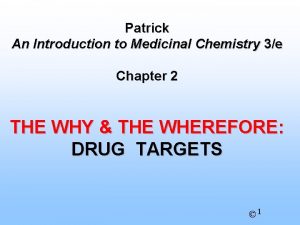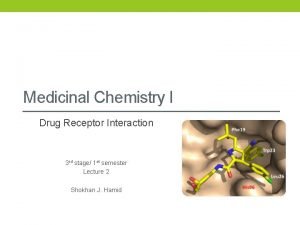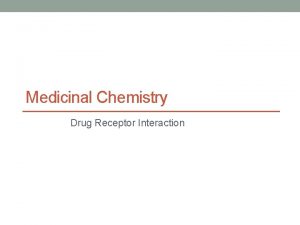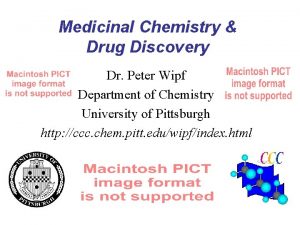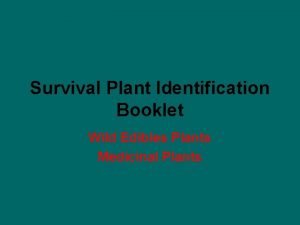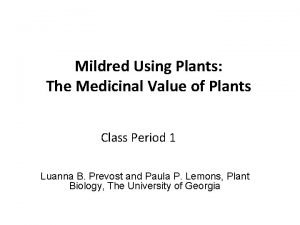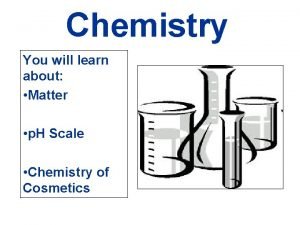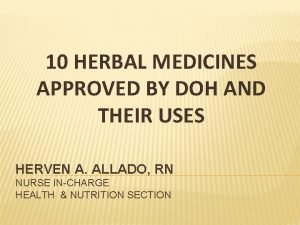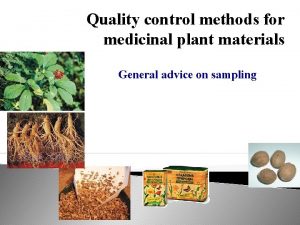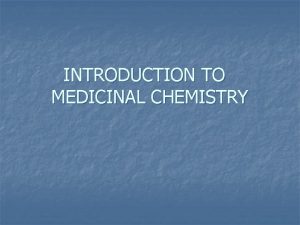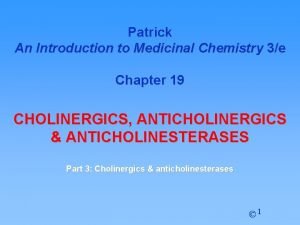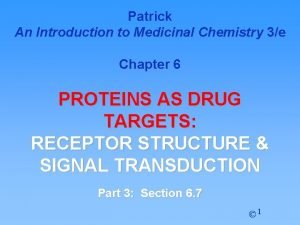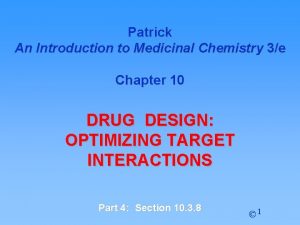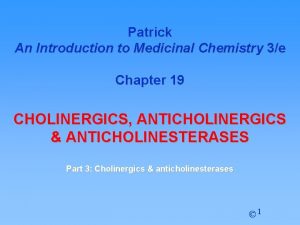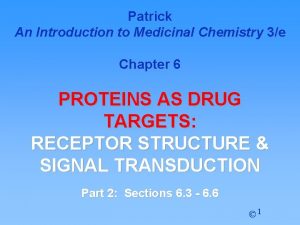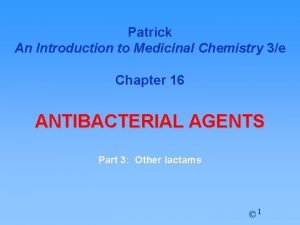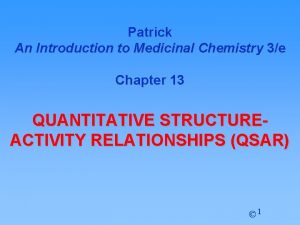Patrick An Introduction to Medicinal Chemistry 3e Chapter










- Slides: 10

Patrick An Introduction to Medicinal Chemistry 3/e Chapter 6 PROTEINS AS DRUG TARGETS: RECEPTOR STRUCTURE & SIGNAL TRANSDUCTION Part 1: Sections 6. 1 - 6. 2 © 1

Contents Part 1: Sections 6. 1 - 6. 2 1. Receptor superfamilies 2. Ion channel receptors (Ligand gated ion channels) 2. 1. General structure (3 slides) 2. 2. Structure of protein subunits (4 -TM receptor subunits) 2. 3. Detailed structure of ion channel 2. 4. Gating (2 slides) [9 slides] © 1

1. Receptor superfamilies RESPONSE TIME • ION CHANNEL RECEPTORS • G-PROTEIN COUPLED RECEPTORS • KINASE LINKED RECEPTORS msecs MEMBRANE BOUND seconds minutes • INTRACELLULAR RECEPTORS © 1

2. Ion channel receptors (Ligand gated ion channels 2. 1 General structure Receptor Binding site Messenger Cell membrane INDUCED FIT ‘GATING’ (ion channel opens) Cell membrane Five glycoprotein subunits traversing cell membrane Cationic ion channels for K+, Na+, Ca 2+ (e. g. nicotinic) = excitatory Anionic ion channels for Cl- (e. g. GABAA) = inhibitory © 1

2. Ion channel receptors (Ligand gated ion channels Transverse view (nicotinic receptor) Binding sites Ion channel a b Cell membrane d a a g g a b d 2 xa, b, g, d subunits Two ligand binding sites mainly on a-subunits © 1

2. Ion channel receptors (Ligand gated ion channels Transverse view (glycine receptor) Binding sites Ion channel a a b a Cell membrane b a a b 3 xa, 2 x b subunits Three ligand binding sites on a-subunits © 1

2. Ion channel receptors (Ligand gated ion channels 2. 2 Structure of protein subunits (4 -TM receptor subunits) Neurotransmitter binding region Extracellular loop H 2 N CO 2 H Cell membrane TM 1 Intracellular loop TM 2 TM 3 TM 4 Variable loop 4 Transmembrane (TM) regions (hydrophobic) © 1

2. Ion channel receptors (Ligand gated ion channels 2. 3 Detailed structure of ion channel Protein subunits TM 4 TM 1 TM 2 TM 3 TM 1 TM 2 TM 4 TM 3 TM 1 TM 3 TM 4 TM 2 TM 1 TM 3 TM 4 Transmembrane regions Note: TM 2 of each protein subunit ‘lines’ the central pore © 1

2. Ion channel receptors (Ligand gated ion channels 2. 4 Gating Neurotransmitter binds Induced fit at binding site Rotation of 2 TM regions of each protein subunit ‘Domino effect’ Ion flow TM 2 Cell membrane TM 2 TM 2 Transverse view of TM 2 subunits TM 2 Transverse view of TM 2 subunits TM 2 Closed Open © 1

2. Ion channel receptors (Ligand gated ion channels 2. 4 Gating • Fast response measured in msec • Ideal for transmission between nerves • Binding of messenger leads directly to ion flows across cell membrane • Ion flow = secondary effect (signal transduction) • Ion concentration within cell alters • Leads to variation in cell chemistry © 1
 Patrick an
Patrick an Medicinal chemistry lectures
Medicinal chemistry lectures Drug receptor interaction medicinal chemistry
Drug receptor interaction medicinal chemistry Drug-receptor interaction
Drug-receptor interaction Medicinal chemistry
Medicinal chemistry Jewel weed medicinal
Jewel weed medicinal Objectives of medicinal plants
Objectives of medicinal plants Mixtures of organic substances and a medicinal agent are:
Mixtures of organic substances and a medicinal agent are: Tsaang gubat benefits
Tsaang gubat benefits Quality control methods for medicinal plant materials
Quality control methods for medicinal plant materials Medicinal horticulture definition
Medicinal horticulture definition
